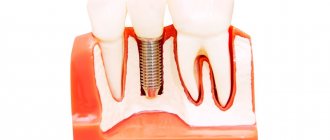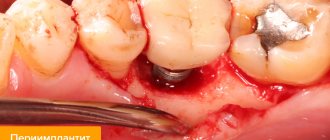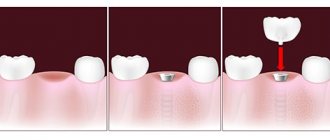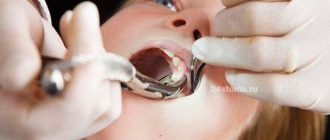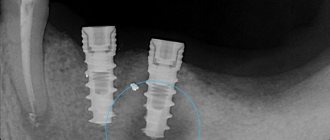Why do you need stitches after wisdom tooth removal?
Removing the “eight” is a surgical procedure that involves dissecting the tissue in the area of the “wise” tooth. After the tooth is extracted, the gum must be sutured so that it heals without complications. A classic example is when, after suturing, a person is scheduled for a follow-up visit to the dentist. At this stage, it is important to evaluate the process of tissue regeneration and make sure that there are no complications after wisdom tooth removal.
When else do you need stitches? For example, when a dental operation needs to be performed urgently, the dentist does not have the opportunity or time to perform blood clotting tests on the patient (a common picture during dental operations after injuries). In this case, the stitches perform the task of preventing bleeding.
Why do the seams come apart?
According to statistics, implant failure does not occur very often. However, such a complication can lead to serious consequences, the main one being non-healing of the structure. Let's look at the most common reasons for this phenomenon:
- Individual characteristics of the body, mainly the incorrect structure of the jaw or rejection of the material from which the thread is made can play a role.
- Not sterile conditions, due to which the wound got infected. Severe swelling and hyperemia occurs, which causes the seam to diverge.
- Neglecting advice from specialists. This may include errors in nutrition or lack of hygiene and medication measures.
- Poor quality surgical thread.
- Insufficient experience of the doctor, due to which the suturing process was performed incorrectly.
How do doctors apply stitches?
Sutures are the junction of soft tissues that were cut to remove a wisdom tooth from the socket. As a rule, figure eights “sit” very firmly in the jaw, are attached to the bone by two roots, and sometimes stand unevenly, resting against neighboring teeth. There is no way to do this without a surgical incision.
To carefully remove a molar, the surgeon makes one or two incisions in the gum, after which he loosens the tooth with a special tool and removes it. Bleeding occurs at the root site; sutures are carefully placed with special threads.
The first day after suturing, bleeding should not be too active - it is the sutures that seem to hold it back. They also connect layers of dissected tissue, which naturally grows together. With high-quality sutures, there should be no severe pain or discomfort, and on the third to fifth day after the operation, the person will not feel any swelling of the gums in the operated area.
The sutures prevent infection from entering the open wound. The better the wound is closed with sutures, the lower the risk of complications and accidental infection.
A follow-up visit after surgery is scheduled 5–7 days later. If the patient is bothered by the wound earlier, he makes an emergency visit.
The dentist assesses the condition of the gums, may prescribe an x-ray, and examines the stitches in detail. If the wisdom tooth removal went without complications, the sutures can be removed after a week. If complete healing of the wound has not occurred, the sutures remain for several more days.
Dentistry for those who love to smile
+7
Make an appointment
Useful tips for oral care
- hold the cotton swab applied by the doctor for 20-30 minutes;
- within 2-3 hours after surgery, be sure to apply cold compresses to reduce tissue swelling;
- carry out oral baths (not to be confused with rinsing) with antiseptic drugs for 3-5 days: “Miramistin”, “Chlorhexidine 0.5%” or other drugs prescribed by a doctor can be used as medicinal solutions;
- after 3-5 days, start using a toothbrush - only a soft one for the operated area, as well as a new one, without bacteria on it. The teeth of the opposite jaw can be brushed immediately, the main thing is to avoid the area of the extracted tooth;
- chew food on the side opposite the injured area;
- You can drink water immediately, preferably warm;
- You can eat only after the anesthesia wears off, that is, after 2-3 hours;
- Lead a quiet lifestyle, try to avoid physical activity and heavy lifting for 5-7 days.
How to understand that complications have arisen after suturing?
Alarming symptoms after removing the “eight” are as follows:
- heavy bleeding that lasts more than a day;
- severe pain, throbbing pain that prevents you from sleeping or leading a normal life;
- very large swelling;
- redness in the intervention area;
- blood in saliva in the first three days after the intervention;
- elevated body temperature.
In all these cases, you must consult your doctor. It is possible that stitches will have to be stitched again to avoid complications.
Remember that removing teeth does not hurt, and removing stitches does not hurt either! The main thing is that this work is performed by a professional.
What happens to gum tissue during the implantation process?
There are different types of implants: subosseous implants are inserted into the jaw bone, periosteal implants are inserted into the soft tissues of the jaw. Sometimes the socket of an extracted tooth is used for implantation, but in some cases it is necessary to artificially deepen the socket or completely dissect the gum from the outside - this is done either with a scalpel or a laser.
After the incision, surgical sutures are made on the gums to hold the tissue until it heals completely.
In some cases, after installation of the implant, gum grafting is performed separately - then healing takes several weeks longer.
In what cases does pain become a symptom of complications?
We found out how long a tooth should hurt after its removal and how long the recovery takes. But what to do if the symptom becomes more pronounced, the pain does not subside, and more than 5 days have passed since the procedure - complications have probably appeared. If the mucous membrane in the causative area is swollen and red, there is no blood clot in the hole and there are signs of suppuration, you need to urgently go to the doctor. Let's consider the main prerequisites for the development of complications.
Due to the fault of the dental surgeon
Sometimes problems arise due to the surgeon’s mistakes and shortcomings that were made during the procedure. Here are the most common medical errors that can lead to complications:
- burn of bone tissue during treatment with a drill - if the specialist does not use a handpiece with a supply of coolant, in most cases a thermal burn occurs, which can lead to the development of superficial necrosis and, accordingly, pain. In this case, it is better to immediately consult a doctor to undergo appropriate therapy,
- trauma to the mucous membrane by the sharp edges of the bone walls remaining after removal - if the interradicular bone septum is too high, its edges can protrude above the blood clot, injure the soft tissues of the oral cavity and provoke inflammatory processes,
- tooth fragments in the wound - an incompletely cleaned hole can also lead to tissue infection and the development of inflammation. To remove the fragments, you will need to see a doctor again,
- “dry socket” is the name given to a pathological phenomenon in which a blood clot is damaged or its formation does not occur at all. The reason may be the patient’s incorrect actions during the rehabilitation period, as well as incorrect technique for performing the procedure. For example, this happens if a specialist injects too much anesthetic with a component that causes vasospasm - a vasoconstrictor. This may prevent the formation of a protective clot and normal tissue healing,
- refusal to apply sutures - sometimes doctors decide that there is no particular need for sutures, even if for removal they needed to peel off a small area of the mucous membrane. If the situation is in doubt, it is better to apply at least one suture to avoid undesirable consequences,
- refusal of antibiotics - after extraction, a specialist usually prescribes antibiotics that prevent the spread of infection in injured tissues. If the doctor has not prescribed any medications, the risk of complications will increase many times over.
If the tongue constantly clings to sharp fragments of the tooth remaining in the sockets, a painful reaction to cold and hot liquid appears, the pain intensifies, the blood clot is not in its place, and the breath smells bad - you need to urgently consult a dentist. It is important to do this as quickly as possible in order to stop the pathological process at its very beginning.
Due to the development of the inflammatory process
When a blood clot is damaged, an inflammatory process often develops - the open wound becomes a fertile environment for the proliferation of bacteria and further infection of tissues. In this case, the pathological process may be accompanied by the release of pus from the socket, the appearance of an unpleasant odor, severe swelling and pain. This inflammatory complication is called alveolitis.
A similar situation can arise both through the fault of the surgeon and the patient himself. For this reason, it is extremely important to strictly follow all the specialist’s instructions during the rehabilitation period, do not rinse the mouth too intensely, avoid the vacuum effect, and eating too hard or viscous food. Treatment requires cleaning the hole from remnants of a blood clot and purulent masses, disinfecting tissues and putting anti-inflammatory medicine into the open wound.
Due to suppuration
Sometimes the blood clot in the wound becomes denser, but no signs of the inflammatory process appear. In such cases, symptoms usually occur indicating the formation of a hematoma and its suppuration:
- the appearance of asymmetry in the face, severe swelling of the gums and cheeks,
- elevated temperature,
- increased pain when touching the gum near the extracted tooth,
- tension of the mucous membrane over the source of suppuration,
- the appearance of cyanosis on the skin in the area of hematoma formation.
Such a nuisance may be associated with accidental damage to the vessel during the administration of anesthesia. At risk are patients with hypertension and diabetes mellitus, as well as those who took aspirin the day before. In this case, you need to go to the dentist - a specialist will cut the tumor, remove the pus and treat the wound with an antiseptic. It may be necessary to install a drainage system to drain purulent masses.
After complex extraction
If there is a complex tooth extraction, for example, an impacted and dystopic number eight, the doctor will need to make a fairly large incision on the mucous membrane, peel off a section of the gum in order to be able to easily remove the element. The procedure may take time, and the rehabilitation period may be complicated by severe symptoms.
“I had my wisdom tooth removed under sedation, because I was very afraid. And then, towards evening, the gums swollen so much that my cheek was swollen. I had to urgently go to the dentist. As it turned out, there was an abscess. Apparently the wound had festered. I had to cut the gum again, remove the pus, and treat it with antiseptics. Then everything took a long time to heal. I won’t delay things like this any longer and I don’t recommend you do so.”
Nina1987, Moscow, from correspondence on the forum www.32top.ru
Sometimes in such situations the development of an inflammatory process is observed. In this case, redness and swelling with a cyst or even an abscess of the jaw can be found in the area of the causative tooth. If the tumor is not removed immediately, it will provoke the release of pus, and this poses a danger to the entire body. In such situations, the doctor will have to remove the pus and disinfect the tissue, and possibly install drainage. All this requires additional surgical procedures, which prolongs the rehabilitation period. To prevent further spread of the infection, antibiotics must be prescribed.
When are the sutures on the gums removed?
It takes 7-10 days for the oral mucosa to heal. The day of suture removal is determined individually in each case. The healing period depends on the general state of health, immunity, hormonal levels and many other factors.
Suture removal is performed when such positive changes as:
- no signs of suppuration;
- no edema or swelling;
- there is no discharge from the wound;
- fabrics have a uniform pink color;
- no general symptoms of intoxication;
- no itching.
Tools used
If a simple elimination requires only two main tools - forceps and an elevator, then in the case of a complex elimination everything is a little different and much more auxiliary devices are required. The instruments are specially developed for dental surgery, which allows all manipulations to be performed without causing severe harm (the level of mechanical damage is minimized).
To extract a molar or premolar, forceps, a bur, an excavator or an elevator are used, and during surgery a scalpel, hammer, scissors, and chisel are used. Let's take a closer look at what the role is and in what situations each of the tools is used.
- forceps. They are used in situations where the coronal part has been preserved and the roots are located in such a way that they can be grasped with an instrument. The specialist sets the axis of the crown to align with the axis of the forceps. For each group of teeth, forceps of a certain shape are designed, having a working part - cheeks, handles, lock;
- elevator. It is used in relation to molars (particularly the eighth) and premolars in the upper jaw. If necessary, using this instrument, the dental surgeon loosens the tooth (or its remains) along with the root, after which it is dislocated with forceps and removed from the gums;
- excavator. According to the principle of operation, it is similar to an elevator; it is used for deep fractures of a molar or premolar. It has an angular working surface, making it easy to penetrate into the hole;
- bit. It is used to eliminate the outer wall of the alveolar process. It is often necessary in a situation where a tooth breaks off and it is not possible to get it out using an elevator or excavator;
- hammer. Its help is resorted to in cases where a tooth is removed using a chisel. The dentist places the instrument in the area between the root and the hole, and at this time his assistant, using a hammer, makes several blows to this area;
- scalpel. Often, complex removal requires making a small incision with minimal trauma. For this purpose, a scalpel is used;
- drill. A drill is usually used during separation, removal of multi-rooted teeth, or removal of bone tissue surrounding a molar or premolar. In such situations, the dental tissue is sawed and removed piece by piece. This is not a simple procedure; it requires sufficient qualifications of a specialist. It is more advisable to resort to it if the root canals have already been previously filled or when the last molar is growing incorrectly (in a horizontal position).
A-Medic dentistry practices complex tooth extraction in Moscow. Qualified specialists work here. For high-quality removal during surgical intervention, the above-described instruments are used. Additionally, the clinic provides all necessary manipulations and services: hemostatic sponge, anesthesia (conduction, infiltration, application), preparation, dressing (using Trichopolum or Alvogil), removal and application of sutures. To make an appointment, just call the numbers provided or fill out an application on the clinic’s official website, after which the administrator will contact you.
How is withdrawal carried out?
In dentistry, self-absorbing sutures are more often used. In this case, the doctor can remove the threads before they dissolve, but this is not necessary.
Stitch removal procedure:
- Antiseptic treatment of the oral cavity to prevent infection.
- Cut the thread in several places.
- Pulling out the material with tweezers.
- Rinse your mouth thoroughly.
After removing the sutures, you may experience mild discomfort for 24 hours. If discomfort increases and complications arise, you should go to the doctor as soon as possible.
